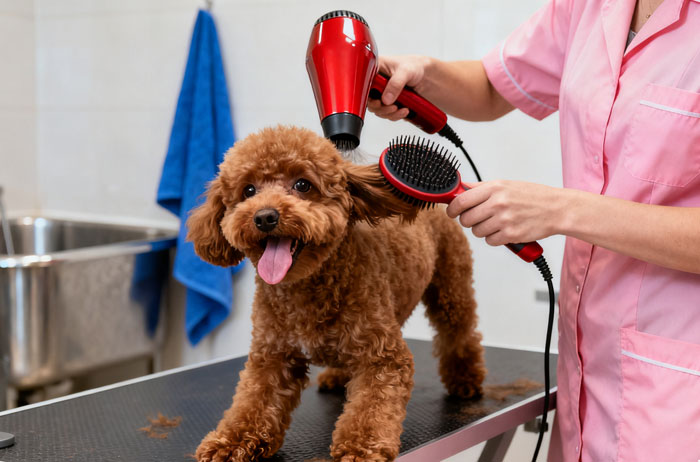Pet Grooming: Seven Essential Procedures You Should Know

With societal progress and rising living standards, pet grooming has evolved beyond basic bathing procedures into a specialized service field encompassing professional tools, techniques, and standardized processes. The distinct coat characteristics and body types of different dog breeds necessitate varied tools and techniques in pet grooming. However, grooming services for most breeds can be conducted according to the following seven core procedures:
1. Undercoat Brushing (Tool: Slicker Brush) — The foundational cleaning step in pet grooming
In the grooming process, undercoating is the first step. Begin by using a slicker brush to groom your dog’s undercoat. This effectively removes dead hair and tangles, reducing shedding in your home environment while keeping the coat smooth, neat, and glossy—laying a solid foundation for subsequent grooming steps.
2. Combing (using a steel comb) — The key step for detecting tangles in pet grooming
After brushing, the grooming process moves to combing. At this stage, use a steel comb to meticulously comb through your dog’s coat again. The core purpose is to check for any remaining small tangles. In pet grooming, if mats aren’t fully detangled before bathing, they become tighter when wet, making them harder to comb out and preventing thorough coat cleansing—compromising grooming results.
3. Bathing — The Core of Deep Cleansing in Pet Grooming
Bathing is the most recognizable yet most professionally demanding step in pet grooming. When bathing your dog, select a pet-specific shampoo suited to its coat type (e.g., long-haired, short-haired, curly-haired) to avoid skin irritation. Bathing water temperature is typically maintained between 35-45°C (95-113°F), with a 1-2°C increase in winter to prevent chills. Regarding frequency, the grooming industry generally recommends bathing long-haired dogs weekly and short-haired dogs every two weeks. This ensures cleanliness without stripping the skin’s natural oils.
4. Blow-Drying — The Foundation for Shaping Fur in Pet Grooming
After bathing, proceed immediately to blow-drying. First, use a highly absorbent pet towel to remove excess moisture from your dog’s coat. Then, thoroughly dry the fur using a hairdryer (set to a low speed and temperature suitable for pets). During the drying process, simultaneously comb the fur with a brush. This helps achieve a naturally fluffy finish, prevents tangles, and prepares the coat for subsequent trimming.
5. Nail Trimming — A Critical Health Protection Step in Pet Grooming
Nail trimming is an often-overlooked yet vital step for your dog’s health. Overgrown nails not only affect gait and mobility but can also lead to skeletal deformities over time. In severe cases, excessively long nails may even pierce the paw pads, causing persistent pain. While seemingly simple, nail trimming in pet grooming follows strict standards: Avoid cutting into the quick (the pink area near the base of the nail) to prevent bleeding. If your dog has experienced bleeding from over-trimming, they may resist future nail trims during grooming sessions and even become irritable.
6. Cleaning Eyes and Ear Canals — Key Disease Prevention in Pet Grooming
Pet grooming focuses not only on appearance but also on health protection, with cleaning eyes and ear canals being crucial preventive steps. Dogs primarily interact with humans through their eyes. If discomfort arises, they may scratch with their paws, risking damage to the eyeball and cornea. Ear canals (especially in floppy-eared or long-haired breeds) have poor ventilation, making them prone to bacterial growth and ear infections. Frequent ear scratching, head shaking, or foul-smelling discharge often signal an ear issue. Therefore, regular visits to a professional pet grooming salon for eye and ear cleaning can effectively prevent various eye and ear diseases, safeguarding your dog’s health.
7. Hair Trimming — Enhancing Appearance and Practicality in Pet Grooming
Hair trimming is the final step in pet grooming and is crucial for improving your dog’s appearance and daily convenience. While healthy dogs possess self-grooming instincts, excessively long fur can still cause issues: overgrown rear fur hinders hygienic defecation, excess abdominal and leg fur easily traps dirt and restricts movement, while overly long paw fur leads to slipping and increased tripping risks. Therefore, all long-haired dogs require regular trimming as part of pet grooming services. Short-haired dogs may also receive targeted trimming as needed, ensuring your dog remains both aesthetically pleasing and comfortable.
admin
-
Sale!

Washable Pet Cooling Pad for Cats and Dogs
$10.99Original price was: $10.99.$9.99Current price is: $9.99. This product has multiple variants. The options may be chosen on the product page -
Sale!

Washable Cat Window Hammock Cooling Bed
$23.99Original price was: $23.99.$22.99Current price is: $22.99. -
Sale!

Tropical Amphibian Rainforest Tank, Lizard Cage
$38.99Original price was: $38.99.$36.99Current price is: $36.99. -
Sale!

Silent 4-in-1 Waterproof Charging Dog Hair Trimmer
$49.88Original price was: $49.88.$47.99Current price is: $47.99.